As an Amazon Associate, we earn from qualifying purchases with no additional costs for you.
Buying knives for the kitchen can be an addictive and expensive habit, especially if you purchase kitchen knives without a plan! Knowing exactly which knives you need in the kitchen will help you purchase good quality knives with purpose and focus, which is our aim for detailing the knives you need!
4 kitchen knives would cover most kitchen needs. A chef’s knife, Santoku, a paring knife, or Petty, and a serrated knife will provide the most versatility in the kitchen without the need for any additional knives. A chef’s knife or Gyuto with a Petty would be ideal for a minimalist selection.
The number of knives you need in your kitchen will largely depend on the type of cuisine you typically prepare. However, for most general kitchens that prepare a wide range of dishes, you can reduce your knife requirements to a core set of knives that will cover most culinary preparation requirements.
If you are interested in checking out the best kitchen knives we recommend buying knives made by the Wüsthof company. You can find them by clicking here (Amazon link).

What Are Must-Have Kitchen (Chef) Knives?
If you work in a professional kitchen or enjoy preparing food at home, you will need a set of knives to properly prepare your ingredients for cooking.
With so many different knife types on the market, it is difficult to come to a finite list of knives that you absolutely cannot do without in the kitchen.
If you are like the rest of us, you will soon find that your knife collection has grown uncontrollably out of hand, and you have a bunch of knives that you hardly use and a handful that are your go-to knives.
We have compiled a minimalist list of knives that you can use as your knife-buying guide if you are just starting out. You can also use this list to trim down your existing knife collection to only those that you really need!
Knife 1: Multipurpose Chef’s Knife
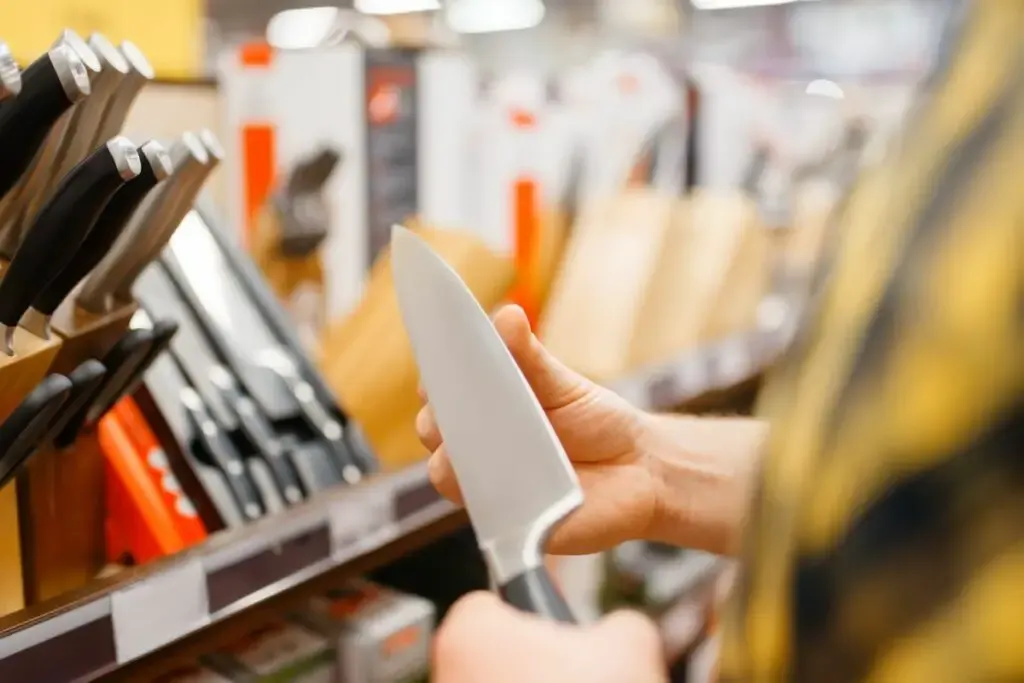
If you ask any experienced chef which knife they use the most, the answer will undoubtedly be their chef’s knife.
This knife should be your number one choice on your list of must-have kitchen knives. The versatility of this knife makes it the knife you will have out on your kitchen counter for the majority of your prep work.
Most chef’s knives have a slightly curved cutting edge, which gives the knife the ability to be used in a rocking chopping motion for finely chopping herbs and soft vegetables. The main curve of the blade is towards the tip, which becomes the fulcrum for chopping with the blade’s heel.
The knife’s sharp edge and the blade height make the knife suitable for accurately and cleanly slicing boneless meat.
Chef’s knives vary in size from 8 inches to 10 inches. We recommend opting for the larger 10-inch blade if you are a large person and an 8-inch blade if you are of smaller stature.
When choosing a chef’s knife, the type of material the knife is made from and the style of the knife are important points to consider. We will detail how these considerations can influence your knife choice a little later in a separate section.
The knife style really comes down to two main options: Western-style chef’s knives, Japanese-style chef’s knives, or Gyuto.
While each style has pros and cons, the choice will largely be personal preference and budget-driven.
We recommend the following knives as good choices for your multipurpose knife in the chef’s knife category.
Yoshihiro Wa Gyuto Japanese Chef Knife
Japanese knives are renowned for their hard steel, lightweight, ultra-sharp knives, which characterize this Gyuto from Yoshihiro.
This Gyuto has an 8.25-inch or 210mm blade forged from high carbon Aus-8 stainless steel. The steel is ice-hardened, which accentuates the hardness of the steel but introduces a higher level of flexibility uncommon in traditional Japanese knives.
The handle on the Yoshihiro Gyuto (Amazon link) is a traditional handcrafted octagonal Wa-style wood handle to offer a perfectly balanced knife for its intended purpose.
The blade is less curved than a Western chef’s knife but has sufficient curve to use rocking motion chopping. The blade is razor-sharp and has a double bevel design, making sharpening easier.
The knife can be used to process meat, fish, and vegetables, and the tapered tip can be used for fast chopping. The knife comes with a sheath called a Saya, which protects the blade during storage.
If you are interested in buying the Yoshihiro Gyuto, check out the latest prices on Amazon.
TIP: Japan and Germany are countries renowned for the quality of their knives. Check out the differences between these two types of knives in the article below:
Japanese Vs. German Knives: 9 Differences & Which Is Better
Zwilling Professional S Chef Knife
The Zwilling Professional S Chef Knife is a Western-style chef’s knife with a standard Western-style handle and blade shape.
The Zwilling Professional S Chef Knife (Amazon link) has an 8-inch blade made from specially formulated stain-resistant carbon steel. The blade is hardened to 57 HRC, which offers good edge retention for western steel.
The edge is ground with a double bevel design to an angle of 15 degrees on each side, offering a fine cutting edge capable of precision slicing.
If you are interested in buying the Zwilling Chef knife, check out the latest prices on Amazon.
Knife 2: Vegetable Knife
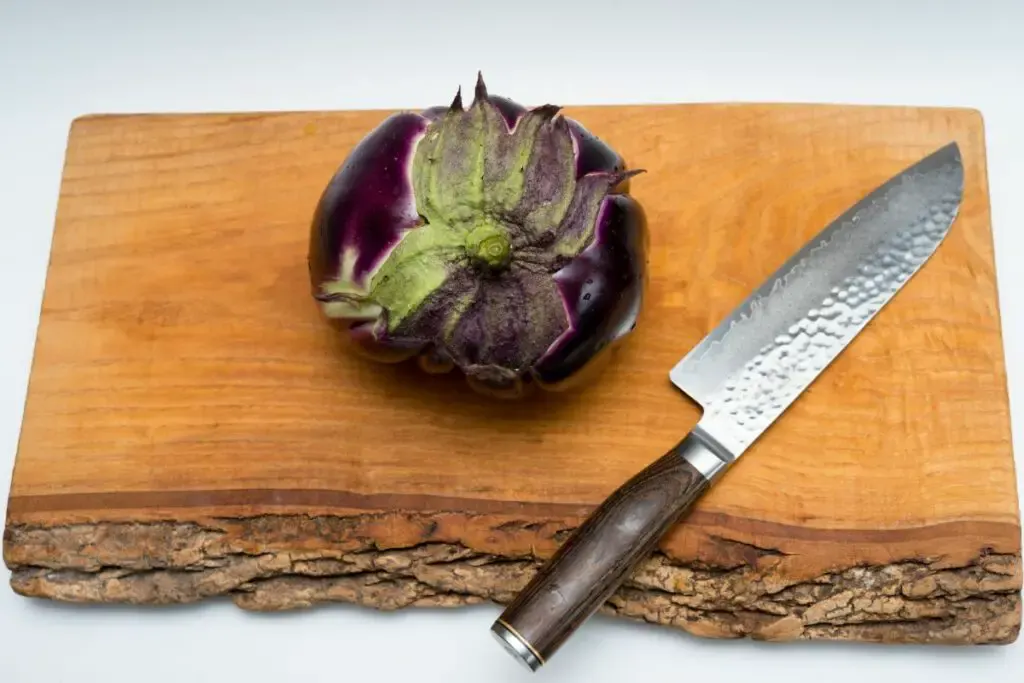
When it comes to processing vegetables in the kitchen, the knife that comes to mind for most people is the Santoku-style knife. This knife style is so popular that many Western knife makers have emulated the design in many of their mid-size knives.
The Santoku knife is shorter than a chef’s knife, and the blade is not as tall. The cutting edge has less of a curve, making the knife ideal for up and down fast chopping vegetables and slicing boneless meat, fish, and poultry.
The Santoku is smaller and more agile than larger knife styles, giving it the advantage of processing smaller ingredients. The blade length for this type of knife usually varies between 5 and 7 inches or 127mm to 178mm.
Henckels Classic Hollow Edge Santoku
The Henckels santoku is a Western-style knife made in the classic Santoku style. The handle is typical of Western knives, offering a firm grip on the knife.
The Henckels Classic Hollow Edge Santoku (Amazon link) is a German-made knife featuring stainless steel as the blade material and the hollow scalloped Granton edge on the sides of the blade. The Granton edge helps to break the surface tension against the ingredient being sliced, preventing it from sticking to the blade.
If you are interested in buying the Henckels Santoku, check out the latest prices on Amazon.
Yoshihiro 46 Layer Hammered Damascus Santoku
If you have an eye for a knife that is a bit more upmarket and more prestigious to add to your knife collection, the Yoshihiro Hammered Damascus Santoku is a perfect choice!
The Yoshihiro blade is made from the famous Japanese VG-10 stainless steel core. The 46-layer Damascus finish makes for an aesthetically pleasing finish to the steel. The hammered texture finish on the blade serves the same role as the Granton edge to prevent food from sticking to the blade.
The handle on the Yoshihiro Santoku (Amazon link) is a traditional Wa-style handle for that authentic Japanese look and perfect balance for the blade.
Santoku-style knives are the most sought-after designs for the kitchen due to their versatility. They are often referred to as the baby brother of the Gyuto.
If you are interested in buying the Yoshihiro Santoku, check out the latest prices on Amazon.
TIP: If you are looking for Japanese kitchen knives to chop and process vegetables, then you have many you can choose from. Check out the best ones in the article below:
The 8 Best Japanese Knives For Chopping Vegetables
Knife 3: Paring Knife
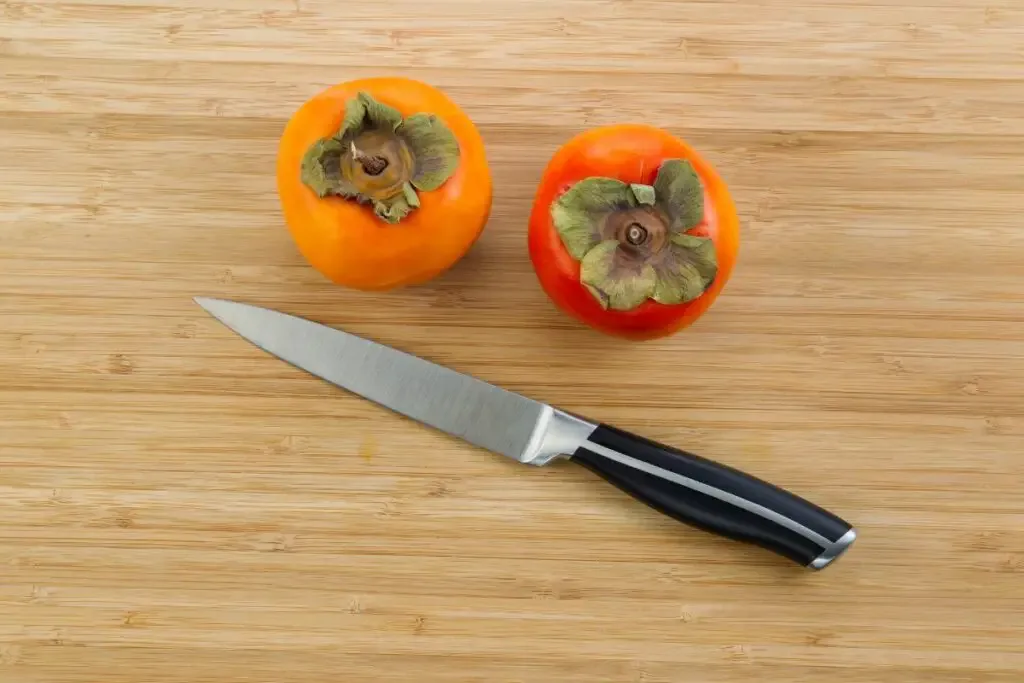
A paring knife is sometimes called a utility knife and is used for a variety of tasks in the kitchen, for which other knives are simply too large and cumbersome.
Paring knives typically have shorter, narrower blades that are more adept at processing smaller ingredients or performing delicate precision work on small ingredients.
Once again, in the small kitchen knife arena, you have a choice between a western paring knife or the Japanese Petty knife.
A Western paring knife is typically shorter than a Petty knife and has a more slender tapering blade. The blade shape of a Petty is noticeably triangular in shape.
A paring knife generally has a blade length of between 3-inches and 4-inches or 80mm and 100mm. A Petty knife is traditionally slightly longer, with a blade length of between 4.7 inches and 7 inches or 120mm and 180mm.
Most chefs prefer a Petty over a paring knife since the Petty is agile and small enough to do everything a paring knife can do and big enough to do more.
We highly recommend the following paring and Petty knives as prime candidates to grace your minimalist kitchen knife set!
WÜSTHOF Classic 3.5″ Paring Knife
This paring knife is a little on the shorter side at only 3.5 inches or 89mm, but it is an extremely useful and agile knife.
The handle is the traditional Western-style handle, providing a comfortable grip and nimbly maneuvering the blade. The blade is a full tang design made from stainless steel and hardened to 58 HRC. The WÜSTHOF Classic 3.5″ Paring knife (Amazon link) is perfect for peeling, chopping, slicing, and dicing.
The knife is German-made with the associated quality, durability, and refinement we have come to expect from knives from this country.
If you are interested in buying the Wusthof Paring Knife, check out the latest prices on Amazon.
Sakai Takayuki 45 Layer Damascus Wa Petty
This Wa Petty knife is nothing short of beautiful, with performance to match its good looks. The 45-layer Damascus steel with a robust VG-10 core and a textured finish along the knife’s spine.
The Sakai Takayuki Wa Petty (Amazon link) is a larger knife than a paring knife, with a blade length of 5.9 inches or 150mm. In my opinion, the additional length makes this knife more versatile than a shorter western paring knife.
This Petty knife has excellent edge retention and is hand-sharpened to ensure superior sharpness right out of the box. The double-bevel blade makes sharpening the knife easier than traditional single-bevel knives.
The octagonal Wa-style handle is made from magnolia wood and is in keeping with the traditional style of the knife without compromising balance and comfort.
If you are interested in buying the Sakai Takayuki Wa Petty, check out the latest prices on Amazon.
TIP: Japanese knives are considered by many to be the epitome of quality kitchen knives, each with its own cutting specialty, such as paring knives. Find out the best Japanese paring knives in the article below:
Best Japanese Knives For Cutting Meat, Bones & Fishes
Knife 4: Serrated Edge Knife
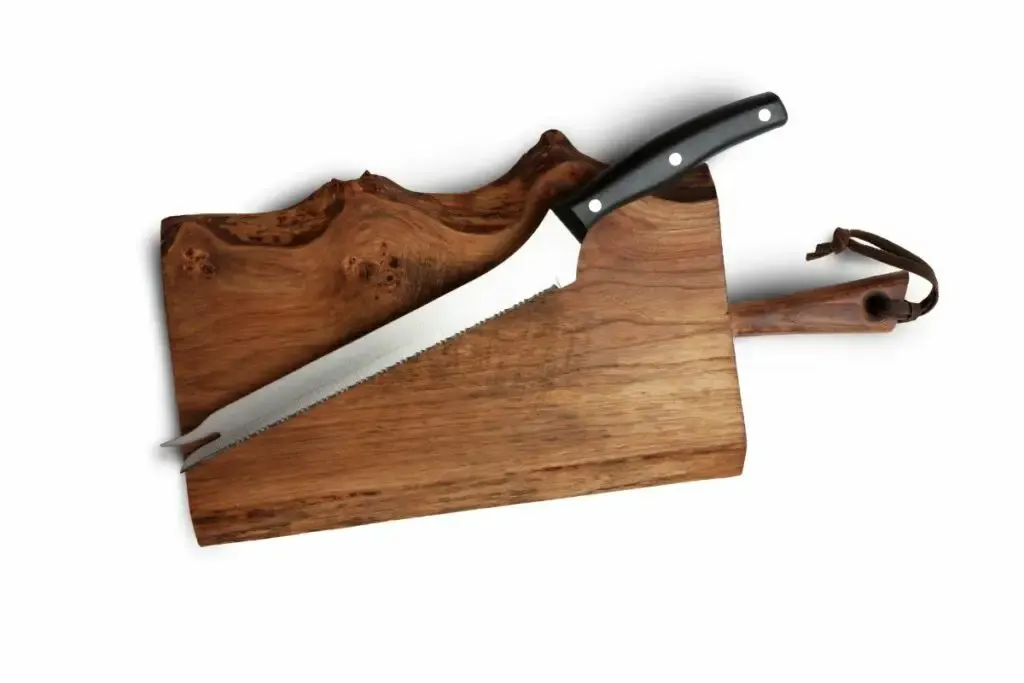
A serrated edge knife or bread knife is an underestimated knife in the kitchen. This knife is designed to cut bread and cakes, but it is not limited to this function.
Serrated-edge kitchen knives also make for good meat carving knives. The serrations on the blade are useful for slicing larger and sometimes tougher cuts of meat, such as large roasts or briskets.
While a chef’s knife can be utilized to carve cooked meat, it does not do well at slicing bread or cakes. Consequently, adding a serrated edge knife to your kitchen knives would complete the set.
We can highly recommend the following knives in the serrated kitchen knife range.
Henckels Forged Synergy Bread Knife
Henckels is a German knife manufacturer, and their 8-inch or 203mm bread knife is made with the same quality German steel as the other knives in their range.
The Henckels Bread Knife (Amazon link) stainless steel blade has an elegant satin finish, and the serrated edge can be used to cut vegetables such as cabbage, any bread, and boneless cooked meat such as cooked ham and roasts or brisket.
If you are interested in buying the Henckels Bread Knife, check out the latest prices on Amazon.
Shun Classic 9″ Bread Knife
If you want a classy serrated knife to match the look of the rest of your kitchen knives without compromising on performance, the Shun Classic 9″ Bread Knife is the ideal choice.
The Shun Classic Bread Knife (Amazon link) has a 9-inch or 228mm blade made from Damascus steel. The core steel is VG-Max, giving strength, durability, and wear resistance to the blade.
This knife is ideal for slicing any bread, including bread with tough outer crusts and soft insides, from sourdough bread to ciabatta, but handles delicate pastries with equal ease. The knife can also be used to slice head vegetables and carve cooked meats.
If you are interested in buying the Shun Classic Bread Knife, check out the latest prices on Amazon.
TIP: Serrated blade knives have an advantage in how long they stay sharp, but the knife will need sharpening at some point. Find out the ways to sharpen a serrated knife in the article below:
DIY Guide: Sharpening A Serrated Knife With & Without Stone
How Many Knives Do You Really Need?
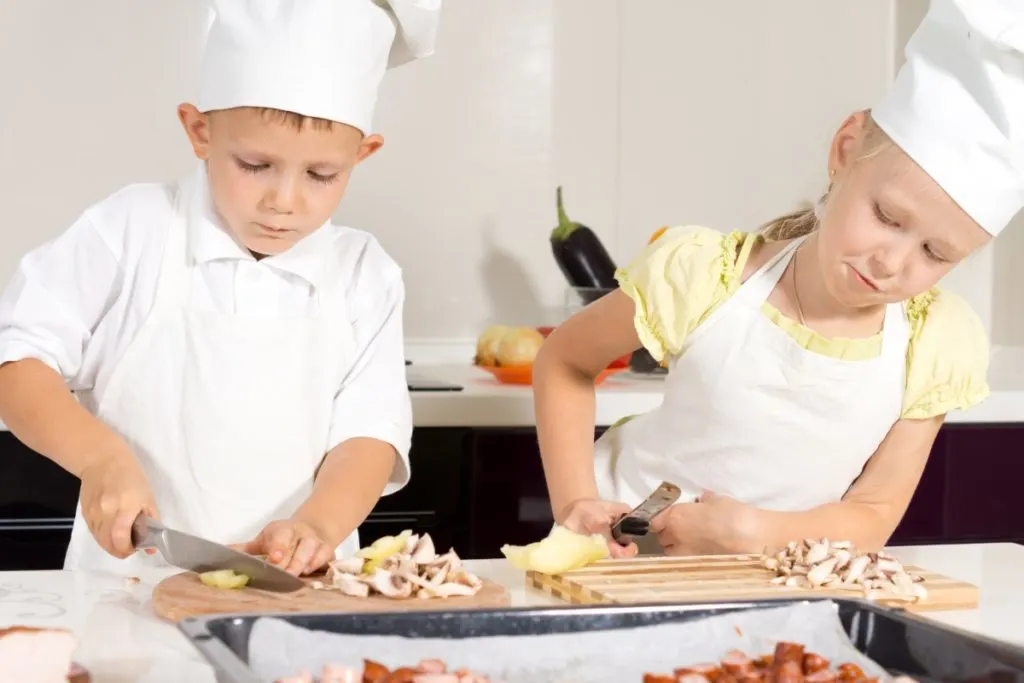
If you had to cut your kitchen knives down to the absolute minimum, you must choose the most versatile knives available.
A bare-bones kitchen knife selection can be whittled down to 2 knives. A good quality chef’s knife or Gyuto combined with an equally good quality Petty or paring knife will provide a good basic knife choice. The versatility of these knives makes them the logical choice.
My personal preference would be for a Petty over a paring knife. A Petty can do everything a paring knife can do but has the additional size that offers greater versatility.
Can You Use One Knife for Everything?
There are different knife shapes and designs for kitchen knives for very good reasons. The shape and design of the knife blades are generally purpose-built to ensure performance for the knife’s intended purpose.
While you can generally use most kitchen knives for multiple functions, at some point, you will encounter situations where the knife does not function well. If you pursue using a knife outside of its intended function, you run the risk of damaging the knife or having an accident with the knife and severely cutting yourself.
Consequently, we recommend that you only use a knife for its intended purpose. This is why the chef’s knife and paring or Petty knives are recommended as the absolute minimum choice in kitchen knives. Both knife types are multipurpose and have the most versatility in the kitchen.
TIP: Kitchen knives can be expensive, but even if your knives are not top of the range, they still need care and maintenance. Check out the best oils for kitchen knives in the article below:
These Are The 2 Best Oils For Kitchen Knives (+ How to Use)
Why Having Fewer Knives Is Better
Conclusion
Whether your kitchen is cluttered with knives or you are starting your kitchen knife journey, having a core set of quality knives will be beneficial for your food preparation.
Starting with a core of 4 good quality kitchen knives, a chef’s knife, Santoku, a paring knife, and a serrated knife will cover most of your kitchen knife needs for years to come. If you are starting small, a chef’s knife or Gyuto, combined with a paring knife or Petty, would be the absolute minimum recommendation!
TIP: As much as we would like them to, our kitchen knives do not last forever! Find out the answer to how often you need to replace your kitchen knives in the article below:
5 Signs You Need to Replace Your Kitchen Knife + How Often
